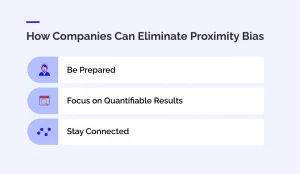The pandemic has affected work operations all over the world. Many companies have had no choice but to switch to fully remote work. However, as some people consider returning to the office, the option remains to operate in a hybrid work model. However, a hybrid work environment can also cause other issues. What may seem to be a compromise can damage your staff’s morale and cause friction through Proximity Bias.
A hybrid workplace has the advantage of a more creative and innovative team. It can also lead to a better balance for employees between work and personal life, and lower overhead costs. For companies seeking global expansion, remote or hybrid work options offer access to a broader range of international talent.
Below we define and address some of the critical factors around proximity bias. Also we discuss how you can maximize the way your team continues to operate smoothly and successfully.
Proximity Bias: What Is It?
Proximity bias is the tendency for managers and bosses to favor the employees who are physically present at the office or company. This was already an issue in the workplace before COVID-19. However, the uptick of remote or hybrid work in the past few years brought these problems to the fore.
Proximity bias reflects old mindsets about workers and the workplace. It fosters the idea that those in power consider on-site workers better equipped or show better results than those working remotely.
This tendency often leads to managers showing preferential treatment to employees who show up to the office. They may also ignore or overlook the talent and skills of those working remotely. This tends to lead to negative effects on the efficiency of remote workers and independent contractors.
How Do Biases Such As This Affect How Companies Make Decisions?
Proximity bias, is an instance of the brain distorting information and cutting corners without proper reason. This bias is the seemingly “common sense” belief that by seeing someone working, they work harder than someone we cannot see.
This kind of bias can quickly lead to favoritism, unfair treatment, and even discrimination. Studies on this phenomenon are not new. Even a study from 2010 showed that employees observed doing work on-site received better work evaluations and higher raises.
Proximity bias can also lead to the halo effect, where one positive trait becomes more important than any other factor.
This is due to the fact that managers communicate with physically present employees easier and their work can be directly observed. Managers mistakenly perceive these visible actions to be more valuable to the company.
Such unbalanced ideas can quickly result in low retention rates, distrust, and a negative impact on productivity.
How Companies Can Eliminate Proximity Bias
Managers and overseers may be unaware that they are exhibiting signs of proximity bias. However, they should become aware of the problem and how to avoid it. Once this bias is acknowledged, it can foster discussion about how to ensure a workplace is free from preferential treatment.
This requires companies to consider the changes they need to make at every stage in an employees time with the company. When hiring employees for remote jobs and providing Human Resources, key decisions have to be made like whether or not to provide employee services through a local entity.
Below, we’ve compiled a list of tips for companies looking to protect themselves from this issue.
· Be Prepared
In a hybrid work model, a company should inform everyone about updates in a way that respects their work situation. For example, communicate with remote staff regarding upcoming meetings ahead of time. This way, they have more chances to provide feedback.
Collaborative software that everyone can interact with, such as Google Workspace, can be an easy substitute for a physical whiteboard. These options should be in place before hiring staff to work from home or globally.
· Focus on Quantified Results
Managers and Bosses must determine career opportunities and promotions on provable facts. While this may seem obvious, studies show that remote workers often out-perform their in-person colleagues but are still likely to be passed over.
This issue of promotion bias is certainly not strictly limited to remote work vs. in-company work. However, making efforts to remove all types of discrimination will improve employee satisfaction and retention.
Stay connected
Much of a successful team spirit and dynamic energy comes from communication. This doesn’t necessarily about work, such as office chatter or water cooler chats.
Create a “digital watercooler” by allowing your remote employees to share in this spirit. Group chats and online messaging can be a way for everyone to stay connected in a digital office space.
A company should take an active role in this relationship creation by scheduling virtual meetings and check-ins for all staff, remote and in-office.
INS Global Provides HR Expertise Worldwide
Managing a global workforce and ensuring all your employees feel valued and appreciated is difficult. Considering each team member’s different sensitivities and workplace culture can be a full-time job.
That’s why INS Global provides global Employer of Record (EOR) services to over 80 countries worldwide. A Professional Employer Organization, or employer of record solution, can hire your employees on your behalf or take charge of payroll processes among other functions.
We offer the tools and systems necessary to take charge of essential but day to day functions like payroll, benefit and insurance management, compliance assurance, recruitment, and invoicing.
INS Global has a multicultural, multinational team that meets your HR needs and boosts communication with your employees. Our global team has over 15 years of experience working with companies worldwide. Our counselors and communication experts ensure that your workplace is bias-free and efficient.
Contact our team today to learn more.


SHARE